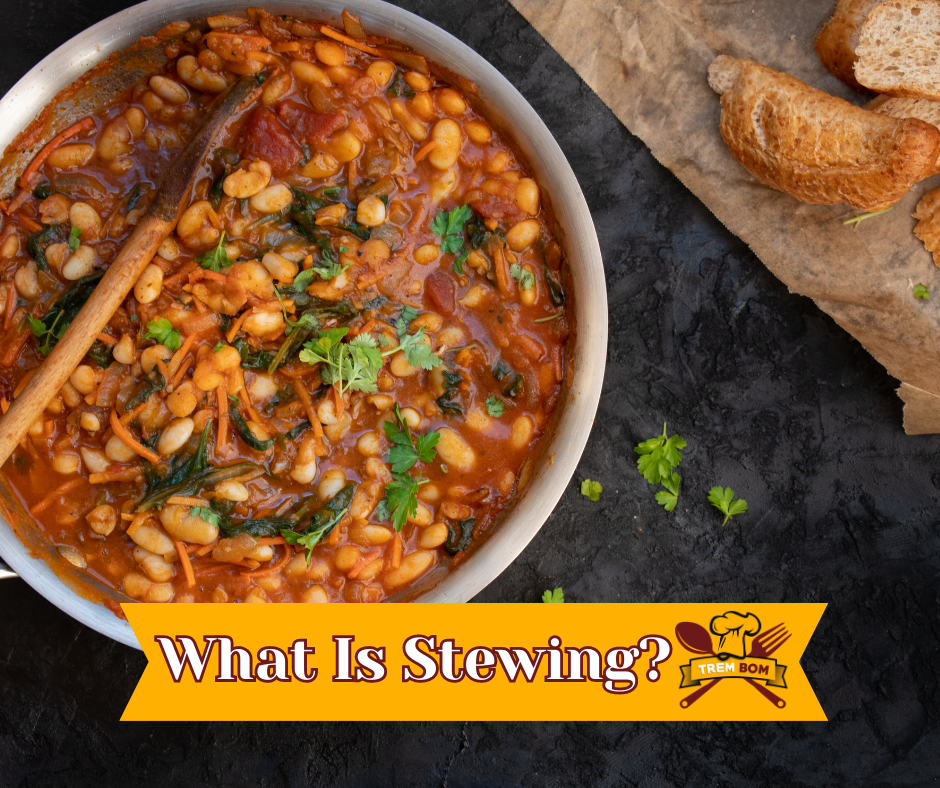
Stew is more than just a meal; it’s a culinary technique that’s been used for centuries. When we talk about stew, we are referring to a slow cooking method where meat and vegetables are submerged in liquid and left to simmer at a low temperature over an extended period. This process transforms even the toughest cuts of meat into tender morsels that can be easily cut with a fork. This article will guide you through the stewing basics, from understanding what stew is, the key components to make a good stew, and some popular stewing recipes around the world.
Understanding Stew: What is a Stew?
A stew is a combination of solid food ingredients that have been cooked in liquid and served in the resultant gravy. Stewing is a versatile and economical method of cooking that allows for a variety of ingredients to be cooked together, forming a flavorful and nutritious dish. The cooking process involves simmering meat and vegetables in a liquid, usually in a dutch oven or on the stove. Stewing is a slow cooking method, and the low temperature and long cooking time tenderize the meat and allow the flavors to meld together.
Stew vs Braise: Similarities and Differences
While stewing and braising may seem similar, they are distinct cooking methods. Both are slow cooking methods that use moist heat and long cooking times to tenderize meat and enhance flavors. However, in braising, the main ingredient is not fully submerged in the cooking liquid as it is in stewing. In addition, braising usually involves larger cuts of meat, while stewing often uses smaller chunks of meat.
Stewing vs. Steaming: Comparing Two Cooking Methods
Both stewing and steaming are methods of slow cooking, often used to tenderize tougher cuts of meat or to fully extract and infuse flavors. However, the process, the results, and their best uses are quite different.
Stewing is a cooking method where small pieces of meat and vegetables are fully submerged in a liquid – typically a broth or stock – and slowly cooked over low heat. The purpose of stewing is to tenderize tougher cuts of meat, while the vegetables and meat lend their flavors to the liquid, creating a rich and flavorful gravy or broth. Stewing is a great method for one-pot meals and heartier dishes, especially during colder months.
Steaming, on the other hand, is a moist-heat cooking method that doesn’t involve liquid directly touching the food. Instead, food is placed in a steamer basket over a pot of boiling water, and the steam cooks the food. This method is gentle and preserves the texture, color, and nutrients of the food, making it ideal for delicate items like fish, vegetables, and dumplings. Unlike stewing, steaming doesn’t inherently infuse the food with added flavors from a cooking liquid, but it allows the food’s natural flavors to shine through.
The similarities between the two methods include their slow cooking nature, and that they both typically result in tender, moist food. They are also both excellent methods for cooking tougher cuts of meat or dense vegetables.
The differences primarily revolve around their use of liquid and the resulting flavors. While stewing immerses the ingredients in a liquid that becomes a part of the final dish, steaming uses water (or occasionally other liquids for aromatic purposes) that doesn’t typically form part of the final dish. Stewing generally provides a richer, more complex flavor, whereas steaming offers a clean, simple flavor that showcases the food’s natural taste.
Stewing Basics: The Cooking Process
Selecting the Cuts of Meat for Stewing
When selecting cuts of meat for stewing, it’s often the tougher cuts that work best. These cuts, like brisket or oxtail, are usually more economical and contain a good amount of connective tissue. This tissue breaks down during the slow cooking process, contributing to the meat’s tenderness and the stew’s richness. Cuts of meat suitable for stewing are often the darker meat, due to their longer muscle fibers.
Preparing Meat and Vegetables for Stewing
Stewing meats is one of the most popular ways to make a tender, hearty dish. Popular dishes like beef stew and ratatouille are great examples of stewing. To prepare the meat for stewing, it’s often beneficial to dust the meat in seasoned flour and then sear it on all sides in a little oil. This helps to develop a richer flavor in the stew. Vegetables such as celery, fennel, leek, and others are usually cut into small pieces and added to the stew. These vegetables, along with aromatic herbs and spices, enhance the overall flavor of the stew.
The Cooking Method: Braising and Simmer
Stewing starts with browning the meat, usually dusted in seasoned flour, on all sides in a hot pan. This not only enhances the flavor but also helps to thicken the stew. Then, mirepoix (a mixture of diced vegetables) is added and cooked until they are softened. The pan is deglazed with a liquid (even water, wine, or brown stock can be used), and the meat is added back in, along with any additional vegetables or other ingredients. The liquid is brought to a boil, then reduced to a simmer. The stew is then left to cook, covered, for several hours until the meat is fork-tender and the flavors have melded together.
Key Components of a Good Stew: Liquid, Browning, & More
The Role of Liquid in Stewing
Liquid plays a significant role in the stewing process. It serves as the medium for heat transfer and also helps to tenderize the meat and extract flavors from the ingredients. The liquid is usually a mixture of broth or stock, wine, and water. As the stew cooks, the liquid slowly evaporates, concentrating the flavors in the pot. The cooking liquid eventually forms a flavorful gravy, which is often thickened before serving.
The Importance of Browning in Stews
Browning is a critical step in the stewing process. It involves searing the meat on all sides before it’s stewed. This process, known as the Maillard reaction, imparts a rich, complex flavor to the stew. It also produces delicious drippings that are later deglazed and incorporated into the stew.
How to Thicken Your Stew
There are several ways to thicken a stew. One method is to use a roux, a cooked mixture of flour and fat. Another is to dust the meat in seasoned flour before browning. This not only helps to brown the meat but also thickens the stew as it cooks. Finally, the stew can be simmered uncovered for the last part of the cooking process, allowing some of the liquid to evaporate and the stew to naturally thicken.
Popular Stewing Recipes Around the World: Irish Stew, Gumbo, & Khoresht
The Traditional Irish Stew
One of the most famous stewing recipes is the Irish stew. Traditional Irish stew is a one-pot dish made with the main ingredients of mutton, potatoes, onions, and parsley. However, there are countless variations of this recipe that include other vegetables such as carrots and celery.
The Flavorful Gumbo
Gumbo, a stewing recipe native to Louisiana, is known for its bold flavors and thick consistency. This stew typically includes meat or shellfish, a strong stock, a thickener, and the “Holy Trinity” of vegetables: celery, bell peppers, and onions. Some recipes also call for the addition of okra or filé powder to thicken the stew.
The Exotic Khoresht
Khoresht is a traditional Persian stew that is slow-cooked and often served with basmati rice. There are many variations of khoresht, with ingredients ranging from meat, fruits, beans, and various spices. This stew is known for its balanced flavors and the tender texture of its meat.
Conclusion
Learning to make a good stew can be a fun and rewarding culinary adventure. Whether you’re making a traditional Irish stew, a flavorful gumbo, or an exotic khoresht, the principles are the same: select the right cuts of meat, prepare them properly, and give them the time and care they need to transform into something delicious and comforting. Enjoy the process and the delicious results!
Stewing FAQs
1. What types of meat are best for stewing?
The best cuts of meat for stewing are those that are tougher and have a high amount of connective tissue, such as brisket or oxtail. These cuts become tender and flavorful when cooked slowly.
2. Can I use water as the cooking liquid for stew?
Yes, you can use water as the cooking liquid for stew, but using a mixture of broth or stock and wine can add more flavor.
3. Do I need to brown the meat before stewing?
While it’s not absolutely necessary, browning the meat can add a richer, more complex flavor to the stew.
4. What vegetables can I add to a stew?
You can add a wide variety of vegetables to a stew. Some popular choices include potatoes, carrots, onions, celery, and peas.
5. How can I thicken my stew?
You can thicken your stew by using a roux, dusting the meat in seasoned flour before browning, or allowing the stew to simmer uncovered towards the end of the cooking process to let some of the liquid evaporate.






